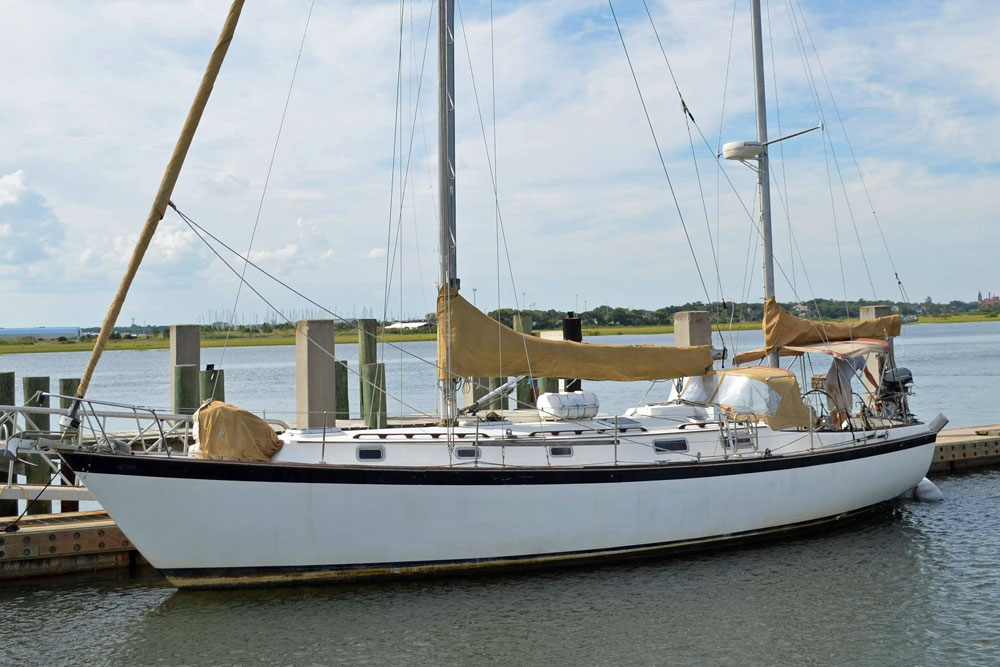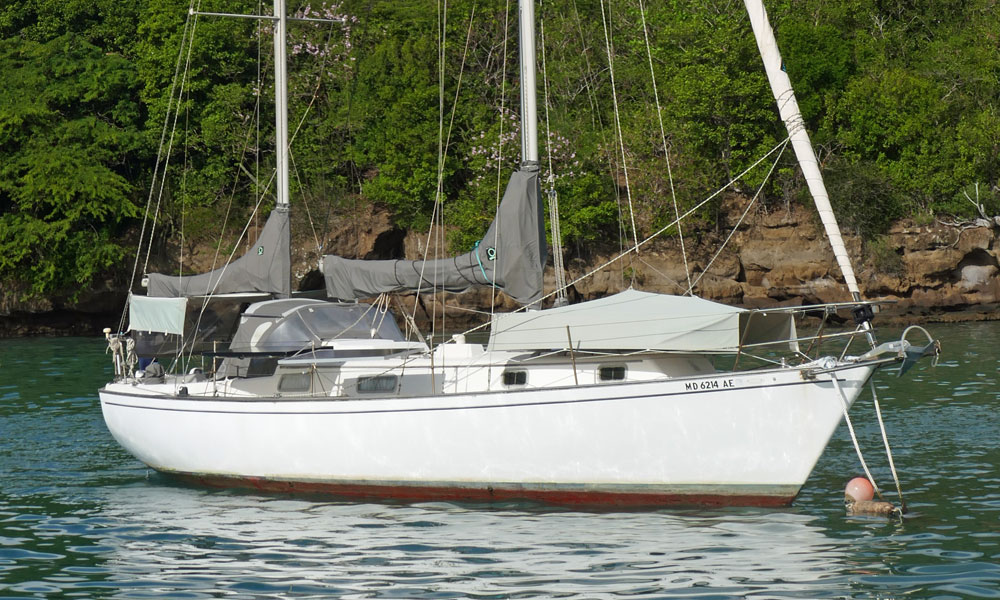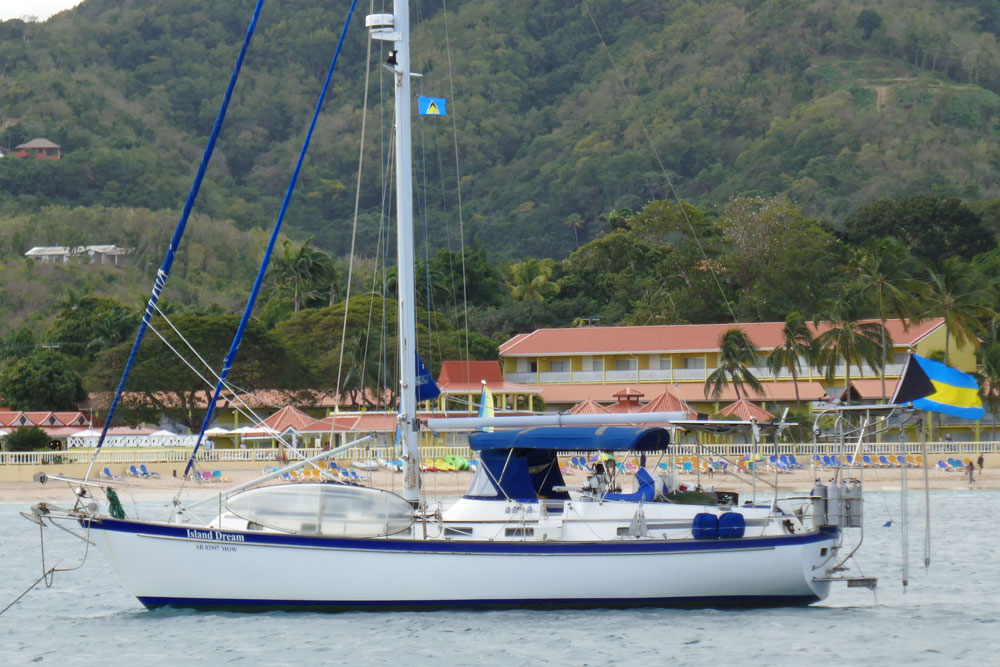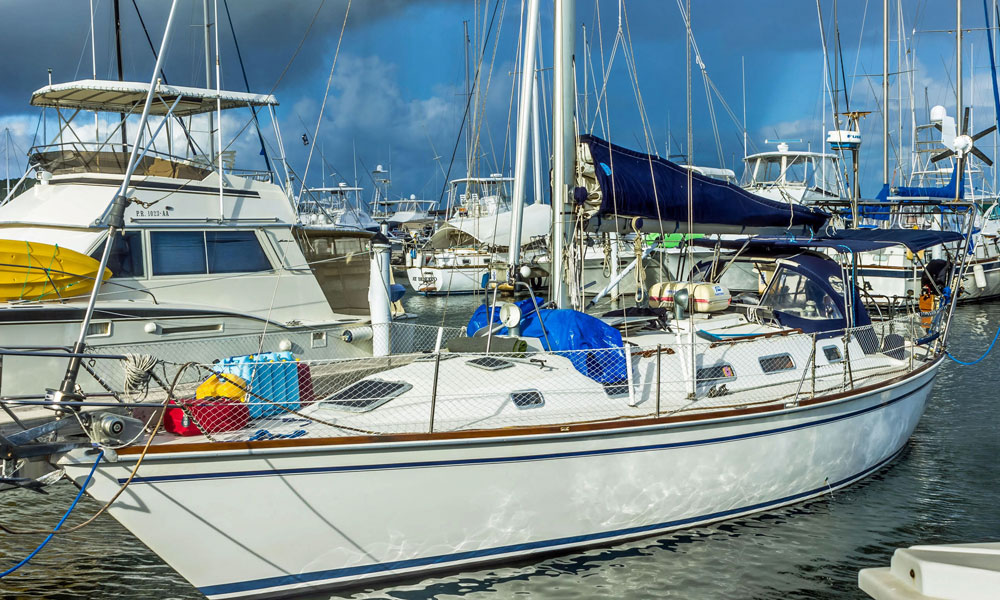- Home
- Cruising Yachts 40' to 45'
- Pearson 424
The Pearson 424 Sailboat
Specs & Key Performance Indicators
The Pearson 424, and aft-cockpit masthead ketch, was designed by Wiiliam Shaw and built in the USA by Pearson Yachts. A centre-cockpit version was also produced which was known as the Pearson 422. The 424 was also available as a cutter.
Published Specification for the Pearson 424
Underwater Configuration: Fin keel and skeg-hung rudder
Hull Material: GRP (fibreglass)
Length Overall: 42'4" (12.90m)
Waterline Length: 33'8" (10.26m)
Beam: 13'0" (3.96m)
Draft: 5'3" (1.60m)
Rig Type: Masthead ketch
Displacement: 21,000lb (9,525kg)
Designer: William Shaw
Builder: Pearson Yachts (USA)
Year First Built: 1978
Year Last Built: 1984
Number Built: 225
Published Design Ratios for the Pearson 424 Ketch
1. Sail Area/Displacement Ratio: 15.6
2. Ballast/Displacement Ratio: 36.2
3. Displacement/Length Ratio: 279
4. Comfort Ratio: 30.0
5. Capsize Screening Formula: 1.8
Performance Predictions, Based on the Design Ratios
The Pearson 424 has a length overall of 42.4 feet, a waterline length of 33.3 feet, a beam of 13 feet, and a draft of 5.3 feet. It has a displacement of 21,000 pounds and a ballast of 7,600 pounds. It has a sail area of 779 square feet for the cutter version and 831 square feet for the ketch version.
Based on these dimensions and weights, we can calculate some design ratios that can give us an idea of how the boat performs in different conditions. These ratios are not definitive indicators of performance, but they can provide some useful comparisons and insights.
Sail Area to Displacement Ratio (SA/D): This ratio measures how much sail power the boat has relative to its weight. A higher ratio means more speed potential, but also more heeling and weather helm. A lower ratio means more stability and comfort, but also less speed and manoeuvrability. The SA/D ratio for the Pearson 424 cutter is 15.6, while the ketch version is 16.6. These are moderate values that indicate a balanced design that can handle a range of wind conditions.
Ballast to Displacement Ratio (B/D): This ratio measures how much weight is in the keel relative to the total weight of the boat. A higher ratio means more stability and stiffness, but also more wetted surface and drag. A lower ratio means less stability and stiffness, but also less wetted surface and drag. The B/D ratio for the Pearson 424 is 36.2. This is a fairly high value that indicates a stiff and stable boat that can carry a lot of sail without excessive heeling.
Displacement to Length Ratio (D/L): This ratio measures how heavy the boat is relative to its waterline length. A higher ratio means more carrying capacity and comfort, but also more inertia and resistance. A lower ratio means less carrying capacity and comfort, but also less inertia and resistance. The D/L ratio for the Pearson 424 is 279. This is a moderate value that indicates a medium displacement boat that can cruise comfortably without being too sluggish.
Capsize Screening Formula (CSF): This formula measures how prone the boat is to capsize in extreme conditions. A lower value means more resistance to capsize, but also more tendency to hobby-horse in waves. A higher value means less resistance to capsize, but also more ability to ride over waves. The CSF for the Pearson 424 is 1.8. This is a low value that indicates a very safe boat that can withstand severe weather.
Production Period and Numbers Produced
The Pearson 424 was produced from 1978 to 1984 by Pearson Yachts in Rhode Island, USA. According to the Pearson Yachts Portal website, there were approximately 225 hulls completed during this period. The first hull number was PEA42001M78A, while the last one was PEA42022M84C. The hull numbers indicate the model (PEA for Pearson), the length (42), the serial number (001 to 022), the month (M for March), the year (78 to 84), and the version (A for cutter, B for ketch, C for sloop).
Alternative Versions & Options
The Pearson 424 was offered in three versions: cutter, ketch, and sloop. The cutter version had a single mast with two headsails: a jib and a staysail. The ketch version had two masts: a main mast with a mainsail and a jib, and a mizzen mast with a mizzen sail and a staysail. The sloop version had a single mast with one headsail: a genoa or jib.
The cutter version was the most popular one, with about 150 hulls produced. The ketch version was the second most popular, with about 50 hulls produced. The sloop version was the least popular, with only about 25 hulls produced.
The Pearson 424 also had some options and variations in the interior layout and equipment. The main difference was in the aft cabin, which could be configured as a double berth, a single berth, or a navigation station. The boat also had different options for the galley, the head, the engine, the tankage, the electrical system, and the deck hardware.
Number & Location of Sleeping Berths
The Pearson 424 had a tri-cabin layout that could accommodate up to six people in three separate sleeping areas. The forward cabin had a V-berth that could sleep two people. The main salon had a U-shaped dinette that could convert into a double berth, and a settee that could serve as a single berth. The aft cabin had either a double berth or a single berth, depending on the configuration.
The boat also had two heads: one forward and one aft. The forward head had a sink, a toilet, and a shower. The aft head had a sink and a toilet.
History of the Boatbuilder
Pearson Yachts was founded in 1959 by cousins Everett and Clint Pearson in Bristol, Rhode Island, USA. They were pioneers in the use of fibreglass as a boatbuilding material, and they produced many successful and innovative sailboats over the years. Some of their most famous models include the Pearson Triton, the Pearson Ensign, the Pearson 35, the Pearson 365, and the Pearson 424.
Pearson Yachts was acquired by Grumman Allied Industries in 1968, and then by Bangor Punta Corporation in 1976. In 1986, Pearson Yachts was sold to Pearson Marine Group, which also owned Cal Yachts and Ranger Yachts. In 1990, Pearson Marine Group was bought by Newport Offshore Yachts, which continued to produce Pearson sailboats until 1991.
After 1991, Pearson Yachts ceased to exist as a boatbuilder, but its legacy lives on in the many boats that are still sailing today. The Pearson Yachts Portal website is a valuable resource for Pearson owners and enthusiasts, as it provides information, specifications, reviews, photos, manuals, and forums for all Pearson models.
Secondhand Values
The Pearson 424 is a sought-after boat in the secondhand market, as it offers a lot of value for its price. According to the Sailboat Listings website, as of August 2023, there are 12 Pearson 424 boats for sale in the USA, with prices ranging from $49,900 to $129,000. The average asking price is $82,658. The oldest boat is from 1978, while the newest one is from 1984. The average length of time on the market is 153 days.
The price of a Pearson 424 depends on several factors, such as its condition, equipment, location, and history. A well-maintained boat with upgraded systems and features will command a higher price than a neglected boat with outdated or faulty equipment. A boat located in a popular sailing area will attract more buyers than a boat located in a remote or inaccessible place. A boat with a documented service record and ownership history will inspire more confidence than a boat with unknown or dubious provenance.
Press Reviews
The Pearson 424 has received many positive reviews from sailing magazines and websites over the years. Here are some excerpts from some of them:
- "The Pearson 424 is one of those rare boats that can do almost anything you ask of it: coastal cruising or offshore passages; liveaboard comfort or weekend fun; classic elegance or modern convenience. It is not surprising that this boat has been so popular for so long among discerning sailors who appreciate quality and versatility." Sail Magazine
- "The Pearson 424 is an excellent example of what can be done with fibreglass when it is used intelligently. It is strong, stiff, light (for its size), and has good sailing characteristics. It is also roomy, comfortable, well laid out below decks, and easy to handle under sail or power." Practical Sailor
- "The Pearson 424 is one of those boats that just feels right. It has a solid feel underfoot and responds well to the helm. It has enough sail area to move along nicely in light airs, but not so much that it becomes overpowered in heavy weather. It has enough displacement to carry all the gear and provisions you need for long voyages, but not so much that it becomes sluggish or hard to manoeuvre." Blue Water Sailing
This article was written with the assistance of Gemini, a large language model developed by Google. Gemini was used to gather information, summarize research findings, and provide suggestions for the content and structure of the article.
Other sailboats in the Pearson range include:
Recent Articles
-
Which Type of Boat Fridge Is The Most Efficient?
Apr 24, 25 05:06 AM
The top opening boat fridge is reputed to be more efficient than the front opening type, but that may not be the case - and here, amongst other boat refrigeration considerations, is why -
Multihull Autopilot Selection is Not Straightforward
Apr 19, 25 01:25 PM
Whether its for a catamaran or a trimaran, tiller or wheel steered, a multi hull autopilot must be endowed with specific performance characteristics... -
Wheel-Steering Autopilots: Your Questions Answered...
Apr 18, 25 03:45 PM
Whatever your question, you should find the answer here
















